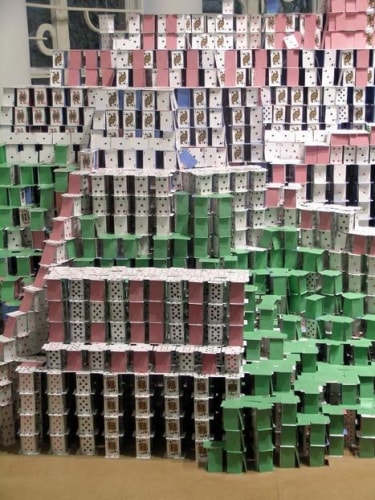
XU ZHEN Untitled, 2009 Playing cards Approximate dimensions: 169 x 51 x 47 inches


展览时间:2009年3月27日至5月30日
开幕酒会:3月27日,周五,晚6 - 8点
画廊地址:上海市岳阳路170弄1号楼1楼
James Cohan画廊很荣幸地宣布《事关信念》将在其上海空间展出。该展览包括了德国画家安塞姆•基弗(Anselm Kiefer)、录像艺术先驱白南准(Nam June Paik)、美国录像艺术家比尔•维奥拉(Bill Viola)、以及来自上海的观念艺术家徐震的作品。艺术家总是变化的代言者。参加展览的这批艺术家来自东西方各国;他们援引各自地域传统里的图像,再现其文化中的神话和隐喻,从而指涉了神圣与精神的层面。当转换于当代艺术的框架之中,这些符号与图像幻化出了一个宽容、怜悯与和谐共存的世界。
在基弗的绘画《Palmostern(2006)》、《Domenica delle Palme(2006)》里,艺术家使用浸渍在石膏里的棕榈叶,将之拼贴于由铅和泥创作而成的画面上。棕榈叶是基督教里同圣枝主日与复活节联系在一起的传统图案。棕榈树被认作是不朽之树,因为它永不凋零,常能新陈代谢、自我再生——新叶生于断枝之处。其被早期的基督教义视作是基督战胜死亡的符号,并成为常见的关于殉难的象征。由此,基弗以圣枝主日为符号体现了基督的受难与复活历程。
美籍韩国录像艺术家白南准的创作中,其代表性的装置作品《微观启示(1994)》最显豁地再现了佛教、冥想与电视的三者关联。作品里,一件铜制佛像端坐在闭路电视前,望着屏幕里自己的影像。通过揭示电子媒介和传统信仰(诸如佛教)的同一沟通方式,白南准在作品里睿智地总结了两者间的共性。眺望未来,他觉得我们的文化很容易被"科技"侵蚀,因此他用艺术促使我们质疑我们的信仰,以善意的怀疑主义审视"技术"。
比尔•维奥拉的录像《显灵(2008)》出自其最近项目《变形记》系列。这件展示于垂直等离子屏幕的录像作品里有一对黑白、飘忽的人影,忽前忽后、虚虚实实,最终穿过一道无形的水柱进入了彩色的光影世界。停息片刻后,人影再度折回其来处。作品将观者带至了生死交汇以及循环往复的变形过程。展览中的另外一件录像《"浮现"习作(2002)》系洛杉矶盖蒂博物馆的委约之作,出自维奥拉的《受难》系列。两位妇女坐在庭院大理石水池两边,沉默不语,耐心等待,只有偶尔才会注意到对方的存在。其中较年轻的妇女突然侧身,打断了她们的守灵,她看着水池,诧异地发现一个青年男子的头从水池里冒了出来。随着他身体上升,池水逐渐外溢至池底和庭院地面。两位妇女随即见证了这神奇的一幕。
上海的观念艺术家徐震为展览委约创作了《无题(2009)》。这件形似布达拉宫的雕塑作品由三千余幅扑克牌搭建而成,欲图打破《吉尼斯世界纪录》。作品延续了这位年轻艺术家对日常/常识中物件的直观再现,它立在圆形展厅正中,沐浴在静谧的阳光下,简约的材质渲染出的肃穆庄重同雕塑本身精巧奇趣的搭建生成了缄默的对话,言简意赅却又不乏机智戏谑之笔。
更多信息,请联系:
Jane Cohan jane@jamescohan.com 或 许先生 Leo Xu lxu@jamescohan.com
March 27 through May 30, 2009
Opening reception: March 27, 6 - 8pm
James Cohan Gallery Shanghai is pleased to present Matters of Faith, a group exhibition featuring works by German painter Anselm Kiefer, video pioneer Nam June Paik, American video artist Bill Viola and Shanghai-based conceptual artist Xu Zhen. Artists have always been the agents of change. In the exhibition Matters of Faith works by four prominent international artists from both the East and West make reference to the sacred and spiritual by borrowing imagery from their respective traditions and by giving material presence to the myths and metaphors of their cultures. As transformed in the framework of contemporary art, these symbols and iconography take on the role of talismans that pave the way for a world where tolerance, compassion and harmony can reign.
In the paintings by German painter Anselm Kiefer, Palmostern (2006) and Domenica delle Palme (2006), the artist uses real palm fronds dipped in plaster that are collaged on to paintings created with lead and mud. The palm branch is traditional Christian iconography associated with the celebrations of Palm Sunday and Easter. The Palm is known as an immortal tree because it never actually perishes but is constantly regenerated— a new sheath of fronds buds from the side of a fallen limb. This symbol was adapted by early Christianity as a sign of Christ's victory over death and it has come to serve as a universal emblem of martyrdom. Thus Kiefer uses the symbol of Palm Sunday to reflect on the Passion and Resurrection of Jesus Christ.
In the work of Korean video pioneer Nam June Paik, the connection between Buddhism, meditation and television is most apparent in his signature installation Enlightenment Compressed (1994), in which a bronze statue of Buddha sits to reflect upon his image on a closed–circuit television monitor. The work conflates the experience of viewing the TV with that of meditation. He draws a witty parallel between new electronic media and older systems of belief such as Buddhism by showing us that they both communicate in the same way. Looking into the future, Paik felt our culture could easily be consumed by technology and he uses art to urge us to question our beliefs and to view technology with a healthy dose of skepticism.
Bill Viola's video work Visitation (2008) is from his recent Transfiguration series. In this work, displayed on a plasma screen mounted vertically on the wall, the black and white image of a pair of ghostly figures approach, coming into focus and eventually breaking through an invisible threshold into a world of color and light. After resting there momentarily, the figures are drawn back through to the other realm. This work brings us to the intersection between life and death and the continuum of that transformation. Also on view is Viola's Study for Emergence (2002), which is based on a work commissioned by the J. Paul Getty Museum in Los Angeles and part of Viola's The Passions series. Two women are sitting on either side of a marble cistern in a small courtyard. They wait patiently in silence, only occasionally acknowledging each other's presence. Their vigil is suddenly interrupted by a premonition as the younger woman turns abruptly and stares at the cistern, watching in disbelief as a young man's head appears. His body rises up, spilling water over the sides and out onto the base and courtyard floor. Together the two women turn to witness this miraculous event.
A newly commissioned work for this exhibition, Untitled (2009), by the Shanghai-based conceptual artist Xu Zhen is a parody of the Potala Palace in Lhasa (initially the winter residence of the 14th Dalai Lama and later converted into a museum and tourist attraction). Built with more than 3,000 decks of playing cards, the sculpture becomes a sensational effort to break The Guinness Book of World Records.
For further information, please contact Jane Cohan at jane@jamescohan.com or Leo Xu at lxu@jamescohan.com